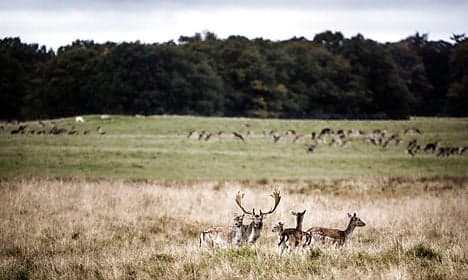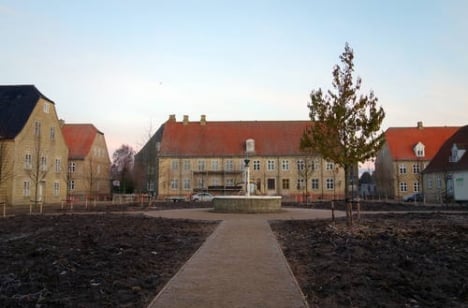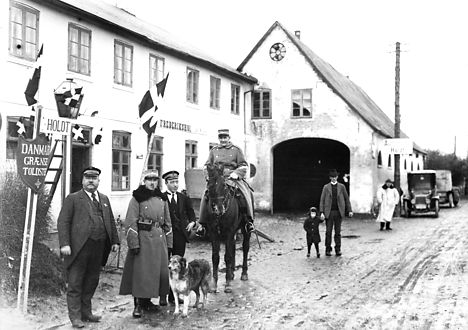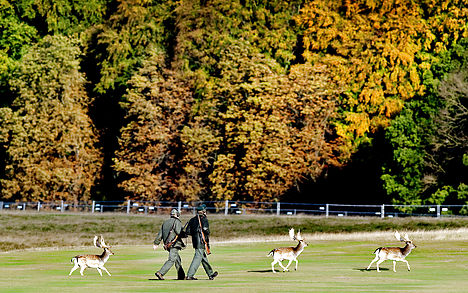Denmark gets two more sites on Unesco list

Just one year after the Wadden Sea and Stevns Cliff were given Unesco World Heritage status, Denmark was honoured with two more additions to the exclusive list.
The Moravian Church settlement in the southern Jutland town Christiansfeld and the royal hunting grounds in northern Zealand were added to Unesco’s World Heritage List over the weekend.
The Christiansfeld Moravian Church settlement was founded in 1773 as a city to represent the Protestant urban ideal. The settlement was constructed around a central church square and was designed in a democratic and egalitarian spirit, including buildings for the common welfare. Some of these buildings are still in active use by the Moravian Church community today.

The Moravian Church square. Photo: Kolding Municipality/Annemette Løkke Berg
“Christiansfeld has now become a world name. I look forward to both tourists and the rest of Denmark opening their eyes to the special thing we have in Christiansfeld,” the mayor of Kolding Municipality, Jørn Pedersen, said in a press release.

Frederikshøj Kro, also known as Den gamle Grænsekro (The Old Border Inn), dates back to the early 1600s. Photo: Unknown/Scanpix
The other new designation covers the two forests of Store Dyrehave and Gribskov and the hunting park of Jaegersborg Dyrehave, located about 30 kilometres northeast of Copenhagen. The grounds were designed for Danish kings and their courts for par force hunting, the practice of hunting with specially-trained hounds. Unesco said that “the site demonstrates the application of Baroque landscaping principles to forested areas.”
The par force hunting landscape also includes The Hermitage Palace (Eremitageslottet), constructed between 1734 and 1736 under orders from King Christian VI, who wanted a place to hold extravagant banquets following his royal hunts. Today, Dyrehaven is the setting of the annual running event Eremitageløbet and the yearly Hubertus steeplechase (Hubertusjagten).

Dyrehaven. Photo: Bax Lindhardt/Scanpix
With the new recognition, Denmark adds two more sites to the six already designated for protection by Unesco. The cultural sites Jelling Mounds Runic Stones and Church, Roskilde Cathedral, and Kronborg Castle were already on the list, as were the natural sites Ilulissat Icefjord, Wadden Sea and Stevns Cliff.
The Wadden Sea and Stevns Cliff joined Unesco’s list in 2014 so the country has seen its Unesco designations double in just one year.
The newly-appointed minister for the environment and agriculture, Eva Kjer Hansen, said that the new Unesco designations were well-deserved.
“The Danish nature is a magnet for tourism and each year our nature plays host to more than 110 million visits. That is proof that not only the Danes, but tourists as well, value the good natural experiences. I’m sure it will be a major boost to the tourism industry to get two new beautiful Danish additions to the Unesco World Heritage List,” Hansen said.
Comments
See Also
The Moravian Church settlement in the southern Jutland town Christiansfeld and the royal hunting grounds in northern Zealand were added to Unesco’s World Heritage List over the weekend.
The Christiansfeld Moravian Church settlement was founded in 1773 as a city to represent the Protestant urban ideal. The settlement was constructed around a central church square and was designed in a democratic and egalitarian spirit, including buildings for the common welfare. Some of these buildings are still in active use by the Moravian Church community today.

The Moravian Church square. Photo: Kolding Municipality/Annemette Løkke Berg
“Christiansfeld has now become a world name. I look forward to both tourists and the rest of Denmark opening their eyes to the special thing we have in Christiansfeld,” the mayor of Kolding Municipality, Jørn Pedersen, said in a press release.

Frederikshøj Kro, also known as Den gamle Grænsekro (The Old Border Inn), dates back to the early 1600s. Photo: Unknown/Scanpix
The other new designation covers the two forests of Store Dyrehave and Gribskov and the hunting park of Jaegersborg Dyrehave, located about 30 kilometres northeast of Copenhagen. The grounds were designed for Danish kings and their courts for par force hunting, the practice of hunting with specially-trained hounds. Unesco said that “the site demonstrates the application of Baroque landscaping principles to forested areas.”
The par force hunting landscape also includes The Hermitage Palace (Eremitageslottet), constructed between 1734 and 1736 under orders from King Christian VI, who wanted a place to hold extravagant banquets following his royal hunts. Today, Dyrehaven is the setting of the annual running event Eremitageløbet and the yearly Hubertus steeplechase (Hubertusjagten).

Dyrehaven. Photo: Bax Lindhardt/Scanpix
With the new recognition, Denmark adds two more sites to the six already designated for protection by Unesco. The cultural sites Jelling Mounds Runic Stones and Church, Roskilde Cathedral, and Kronborg Castle were already on the list, as were the natural sites Ilulissat Icefjord, Wadden Sea and Stevns Cliff.
The Wadden Sea and Stevns Cliff joined Unesco’s list in 2014 so the country has seen its Unesco designations double in just one year.
The newly-appointed minister for the environment and agriculture, Eva Kjer Hansen, said that the new Unesco designations were well-deserved.
“The Danish nature is a magnet for tourism and each year our nature plays host to more than 110 million visits. That is proof that not only the Danes, but tourists as well, value the good natural experiences. I’m sure it will be a major boost to the tourism industry to get two new beautiful Danish additions to the Unesco World Heritage List,” Hansen said.
Join the conversation in our comments section below. Share your own views and experience and if you have a question or suggestion for our journalists then email us at [email protected].
Please keep comments civil, constructive and on topic – and make sure to read our terms of use before getting involved.
Please log in here to leave a comment.